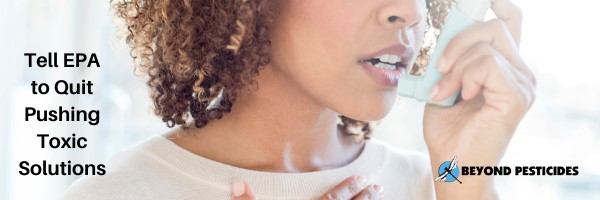26
Oct
Tell EPA to Quit Pushing Toxic Solutions, Especially in Schools
 (Beyond Pesticides, October 26, 2020) A high percentage of the disinfectants approved by EPA for use against coronavirus contain quaternary ammonia compounds (quats). EPA’s approved list is used by schools and other institutions—unfortunately, without guidance for avoiding harmful effects.
(Beyond Pesticides, October 26, 2020) A high percentage of the disinfectants approved by EPA for use against coronavirus contain quaternary ammonia compounds (quats). EPA’s approved list is used by schools and other institutions—unfortunately, without guidance for avoiding harmful effects.
Quats are very toxic. They are especially dangerous in the context of a respiratory pandemic. Quats increase the risk for asthma and allergic sensitization. Evidence from occupational exposures shows increased risk of rhinitis and asthma with exposure to quats. Quats are on the Association of Occupational and Environmental Clinics list of asthmagens and may be a more potent asthmagen than bleach.
One quat, benzalkonium chloride, has also been associated with dermatitis. Quats appear to be sensitizers and irritants to the skin and mucous membranes and are suspected to display an immunologic cross-reactivity between each other and with other chemical compounds containing ammonium ion.
Quats also are mutagenic and reproductive toxicants. Some quats have shown to be mutagenic and to damage animal DNA and DNA in human lymphocytes at much lower levels than are present in cleaning chemicals. Mice whose cages were cleaned with QACs had very low fertility rates.
The continued zeroing in on disinfectants distracts schools from the more important role of measures to reduce airborne exposure in schools. Measures to accomplish this include reducing the time spent indoors, engineering controls that increase ventilation while preventing air movement from one person to another, and use of air filtration.
EPA’s List N disinfectants do not differentiate by levels of toxicity and potential harm to people, especially children. Beyond Pesticides has created a safer list, drawn from List N, which enables people and decision-makers to avoid chemicals that harm.
EPA allows the registration of pesticides that are known to present hazards even though there are less hazardous pesticides on the market. That’s because EPA does not do an alternatives analysis and determine whether a less toxic material and/or a practice can get the job done just as effectively. Instead, EPA conducts risk assessments that are admittedly filled with uncertainties in addition to what is known about a chemical’s effects—such as impacts on people with preexisting conditions (comorbidities), effects of multiple exposures to the same and other chemicals (mixtures), and numerous other factors not considered by EPA.
Letter to EPA and Congress
A high percentage of the disinfectants approved by EPA for use against coronavirus contain quaternary ammonia compounds (quats). EPA’s approved list is used by schools and other institutions—unfortunately, without guidance for avoiding harmful effects.
Quats are very toxic. They are especially dangerous in the context of a respiratory pandemic. Quats increase the risk for asthma and allergic sensitization. Evidence from occupational exposures shows increased risk of rhinitis and asthma with exposure to quats. Quats are on the Association of Occupational and Environmental Clinics list of asthmagens and may be a more potent asthmagen than bleach.
One quat, benzalkonium chloride, has also been associated with dermatitis. Quats appear to be sensitizers and irritants to the skin and mucous membranes and are suspected to display an immunologic cross-reactivity between each other and with other chemical compounds containing ammonium ion.
Quats also are mutagenic and reproductive toxicants. Some quats have shown to be mutagenic and to damage animal DNA and DNA in human lymphocytes at much lower levels than are present in cleaning chemicals. Mice whose cages were cleaned with QACs had very low fertility rates.
The continued zeroing in on disinfectants distracts schools from the more important role of measures to reduce airborne exposure in schools. Measures to accomplish this include reducing the time spent indoors, engineering controls that increase ventilation while preventing air movement from one person to another, and use of air filtration.
EPA’s List N disinfectants does not differentiate by levels of toxicity and potential harm to people, especially children. Beyond Pesticides has created a safer list, drawn from List N, which enables people and decision-makers to avoid chemicals that harm.
EPA allows the registration of pesticides that are known to present hazards even though there are less hazardous pesticides on the market. That’s because EPA does not do an alternatives analysis and determine whether a less toxic material and/or a practice can get the job done just as effectively. Instead, EPA conducts risk assessments that are admittedly filled with uncertainties in addition to what is known about a chemical’s effects—such as impacts on people with preexisting conditions (comorbidities), effects of multiple exposures to the same and other chemicals (mixtures), and numerous other factors not considered by EPA.
EPA must not recommend toxic disinfectants without providing the context of their damaging impacts and other necessary protective measures.
Thank you.











Signed to support this important petition.
October 26th, 2020 at 4:17 pm